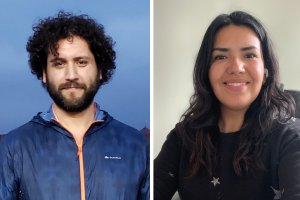The depletion of the ozone layer and its effects on human health and ecosystems was the focus of the Environmental Effects Assessment Panel (EEAP) carried out within the framework of the 35th anniversary of the Protocol of Montréal.
This year, the EEAP was promoted by the Ozone Secretariat of the United Nations Environmental Program (UNEP), and was held from September 19 to 27 in Kalmar, Sweden. It featured a panel of experts, including the researcher from the University of Magallanes, attached to the Cape Horn International Center and the BASE Millennium Institute, Dr. Roy Mackenzie and, the postdoctoral researcher from the University of Magallanes and the Millennium Institute BASE, Dr. Brenda Riquelme del Río.
The Panel brought together professionals with extensive experience in the effects of ozone layer depletion on human health, ecosystems, atmospheric chemistry, ecology, materials engineering, among others. “We were asked to examine the UNEP-EEAP report that will be reviewed on the 35th anniversary of the Montreal Protocol and to participate in the discussion of the impact of this treaty on climate care and conservation of ecosystems and biodiversity,” said Roy Mackenzie.
Regarding the Montreal protocol, the researcher attached to the BASE Millennium Institute indicated that “it has been very effective in protecting the planet’s stratospheric ozone layer and preventing the global increase in UV-B solar radiation on the Earth’s surface. Consequently, this international treaty has prevented the large-scale detrimental effects of high UV-B radiation on agricultural productivity, terrestrial organisms, and ecosystems (…) Thanks to this treaty, the Antarctic ozone hole is expected to close around the 2070s.”

For years, Roy Mackenzie and Brenda Riquelme have focused their efforts on sensorizing and monitoring the moss Polytrichum strictum (Polytrichaceae), conducting experiments in response to the manipulation of UV-A and UV-B light, both in the field and in the laboratory. They have developed a working method in Omora Park, on the north coast of Navarino Island, with the aim of establishing long-term monitoring of bryophytes as indicators of environmental variability in the subantarctic zone of Magallanes.
“Our results on the effect of UV radiation on subantarctic bryophytes will continue to contribute to the quadrennial reports generated by the EEAP-UNEP panel, taking part of a global database that will favor evidence-based decision-making for the countries that are part of the Montreal treaty,” said Roy Mackenzie, also an ecologist at the BASE Millennium Institute.
For her part, Dr. Brenda Riquelme del Río expressed that “receiving the invitation to be part of the review of the report has been tremendously gratifying and challenging, we have taken it as a recognition for our contribution in the study of the effects of the ozone hole on plants from Puerto Williams, the southernmost city on the planet”.
You can learn more about the conference here.
By: Constanza Barrientos
Main photography: image retrieved from the Linnaeus University website in Sweden

